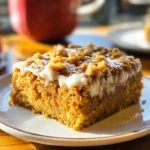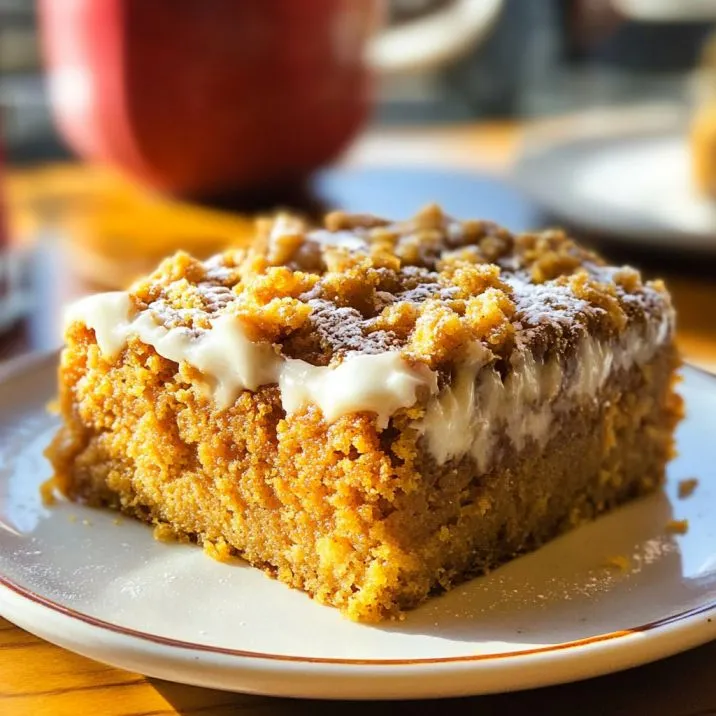Introduction
Pumpkin cake, topped with luscious cream cheese frosting, is a quintessential fall dessert that perfectly balances the warm, earthy flavors of pumpkin with the rich, tangy taste of cream cheese. As the leaves change color and the air turns crisp, the aroma of pumpkin spices fills kitchens, making this cake a beloved treat during the autumn season. With a history rooted in tradition and a flavor profile that appeals to a wide audience, pumpkin cake is more than just a dessert; it’s a celebration of the harvest season. This article explores the origins, health benefits, and step-by-step process of making this delicious cake, along with tips for decorating, serving, and adapting the recipe for various dietary needs.
1. History of Pumpkin in Baking
Pumpkin has been a staple in baking for centuries, with its use dating back to the early settlers in North America. Native Americans were among the first to use pumpkins, roasting them over open fires and incorporating them into various dishes. As settlers arrived, they adapted these practices, creating pumpkin-based recipes that eventually evolved into the sweet desserts we know today.
The earliest versions of pumpkin cake were simple, often made with basic ingredients like flour, eggs, and spices. Over time, these recipes became more elaborate, incorporating ingredients like sugar, butter, and cream cheese, leading to the rich, moist cakes we enjoy now. Different regions also developed their own variations, with some adding nuts, raisins, or even chocolate chips to the mix.
2. Health Benefits of Pumpkin
Pumpkin is not only delicious but also packed with nutrients. It is an excellent source of vitamins A, C, and E, all of which play crucial roles in maintaining good health. Vitamin A, in particular, supports eye health, while vitamin C boosts the immune system. Pumpkin is also rich in dietary fiber, which aids digestion and helps maintain a healthy weight.
Moreover, pumpkin contains antioxidants like beta-carotene, which the body converts into vitamin A. These antioxidants help protect the body from harmful free radicals, reducing the risk of chronic diseases. Additionally, the high potassium content in pumpkin can help regulate blood pressure, making it a heart-healthy ingredient.
3. Choosing the Right Pumpkin for Baking
When it comes to baking, not all pumpkins are created equal. Some varieties are better suited for savory dishes, while others excel in sweets. For pumpkin cake, the best options are typically sugar pumpkins or pie pumpkins, known for their sweet, dense flesh. These varieties provide the perfect texture and flavor needed for a moist and flavorful cake.
While fresh pumpkin can be used, many bakers prefer canned pumpkin puree for its convenience and consistency. If you choose to use fresh pumpkin, it’s essential to prepare it properly by roasting or steaming it until tender, then pureeing it until smooth. Fresh pumpkin puree can be stored in the refrigerator for up to a week or frozen for longer use.
4. Essential Ingredients for Pumpkin Cake
Creating the perfect pumpkin cake starts with the right ingredients. The key components include:
- Pumpkin Puree: Provides moisture and flavor.
- Spices: Cinnamon, nutmeg, and cloves are essential for that classic pumpkin spice flavor.
- Butter: Adds richness and helps create a tender crumb.
- Sugar: Both granulated and brown sugar can be used for sweetness and depth of flavor.
- Flour: All-purpose flour works well, but cake flour can be used for a lighter texture.
Optional ingredients like chopped nuts, raisins, or chocolate chips can add extra flavor and texture to the cake.
5. Step-by-Step Recipe for Pumpkin Cake
To create a delicious pumpkin cake, follow these detailed instructions:
- Preheat the Oven: Set your oven to 350°F (175°C). Grease and flour your cake pans.
- Prepare the Batter: In a large bowl, combine pumpkin puree, sugar, and melted butter. Mix in eggs one at a time. In a separate bowl, whisk together flour, baking powder, baking soda, salt, and spices. Gradually add the dry ingredients to the wet mixture, stirring until just combined.
- Bake the Cake: Pour the batter into prepared pans and bake for 25-30 minutes or until a toothpick inserted into the center comes out clean. Let the cakes cool completely before frosting.
- Prepare the Frosting: Beat softened cream cheese and butter together until smooth. Gradually add powdered sugar and vanilla extract, beating until creamy.
- Assemble the Cake: Spread a layer of frosting on top of one cake layer, place the second layer on top, and frost the entire cake. Decorate as desired.
6. The Art of Cream Cheese Frosting
Cream cheese frosting is the perfect complement to pumpkin cake, offering a tangy contrast to the cake’s sweetness. The basic ingredients include cream cheese, butter, powdered sugar, and vanilla extract. For the best results, make sure the cream cheese and butter are softened to room temperature before mixing.
For a smoother frosting, sift the powdered sugar before adding it to the mixture. If you prefer a slightly different flavor, try adding a teaspoon of maple syrup or a pinch of cinnamon to the frosting.
7. Decorating Ideas for Pumpkin Cake
Decorating a pumpkin cake can be as simple or elaborate as you like. For a classic look, smooth the cream cheese frosting over the cake and finish with a dusting of cinnamon. For a more festive presentation, consider using fall-themed decorations like edible leaves, candy pumpkins, or crushed nuts.
Piping frosting is another way to add elegance to your cake. Use a star tip to create swirls or rosettes on top of the cake. If you’re feeling creative, try creating a pumpkin patch scene with green frosting vines and small fondant pumpkins.
8. Serving Suggestions
Pumpkin cake is best served at room temperature, allowing the flavors to fully develop. It pairs wonderfully with a cup of hot coffee or tea. For a more indulgent experience, serve it with a scoop of vanilla ice cream or a dollop of whipped cream.
If you’re hosting a holiday gathering, consider serving the cake alongside other seasonal dishes like roasted squash or spiced cider. To store leftovers, wrap the cake tightly in plastic wrap and keep it in the refrigerator. It will stay fresh for up to five days.
9. Healthier Variations of Pumpkin Cake
For those looking to enjoy pumpkin cake with a healthier twist, consider these modifications:
- Substitute whole wheat flour for some or all of the all-purpose flour to increase fiber content.
- Reduce sugar by using a natural sweetener like honey or maple syrup.
- Add Greek yogurt to the batter for extra moisture and protein.
- Use olive oil instead of butter for a heart-healthy fat option.
These adjustments can help you enjoy a delicious pumpkin cake with fewer calories and more nutritional benefits.
10. Pumpkin Cake for Special Diets
Pumpkin cake can be adapted for various dietary needs without sacrificing flavor. Here are some options:
- Gluten-Free Pumpkin Cake: Use a gluten-free flour blend and ensure all other ingredients are gluten-free.
- Vegan Pumpkin Cake: Replace eggs with flaxseed meal or applesauce and use vegan butter and cream cheese for the frosting.
- Low-Carb Pumpkin Cake: Substitute almond flour for regular flour and use a low-carb sweetener like erythritol.
- Diabetic-Friendly Pumpkin Cake: Reduce sugar and use a sugar substitute approved for baking.
- Allergy-Friendly Pumpkin Cake: Ensure the recipe is free of common allergens like nuts, dairy, and eggs by using appropriate substitutes.
11. Expert Tips for Baking Success
Baking the perfect pumpkin cake requires attention to detail. Here are some expert tips to help you achieve the best results:
- Measure Ingredients Accurately: Use a kitchen scale for precise measurements.
- Don’t Overmix the Batter: Overmixing can result in a dense cake. Mix just until the ingredients are combined.
- Use Room Temperature Ingredients: Eggs, butter, and cream cheese should be at room temperature for the best texture.
- Test for Doneness: Insert a toothpick into the center of the cake; it should come out clean when the cake is done.
- Cool Completely Before Frosting: Frosting a warm cake can cause the frosting to melt and become runny.
12. FAQs about Pumpkin Cake
- Can I Use a Different Type of Squash?
- Yes, you can substitute other types of squash, such as butternut squash or acorn squash, but the flavor and texture may vary.
- How Long Can Pumpkin Cake Be Stored?
- Pumpkin cake can be stored in the refrigerator for up to five days. It can also be frozen for up to three months.
- What’s the Best Way to Frost a Pumpkin Cake?
- For a smooth finish, apply a crumb coat first, refrigerate the cake, and then apply a final layer of frosting.
- How Do I Make the Cake Moister?
- Ensure you don’t overbake the cake. Adding a bit of sour cream or yogurt to the batter can also help.
- Can I Make Pumpkin Cake Ahead of Time?
- Yes, you can bake the cake layers a day in advance and store them tightly wrapped at room temperature. Frost the cake on the day you plan to serve it.
Conclusion
Pumpkin cake topped with luscious cream cheese frosting is a delightful treat that embodies the flavors of fall. With its rich history, nutritional benefits, and versatility, this cake is a must-try for any baking enthusiast. Whether you’re making it for a holiday gathering or simply to enjoy a cozy afternoon treat, pumpkin cake is sure to impress. So, gather your ingredients, follow the recipe, and savor the deliciousness of this classic autumn dessert.

Pumpkin Cake
- Total Time: 50 minutes
- Yield: 12 servings 1x
- Diet: Vegetarian
Description
A moist and flavorful pumpkin cake topped with rich cream cheese frosting, perfect for fall celebrations and gatherings.
Ingredients
- For the Cake:
- 2 cups all-purpose flour
- 1 ½ cups granulated sugar
- 1 cup canned pumpkin puree
- ½ cup vegetable oil
- 4 large eggs
- 2 tsp baking powder
- 1 tsp baking soda
- 1 tsp cinnamon
- ½ tsp nutmeg
- ¼ tsp ground cloves
- ½ tsp salt
- For the Cream Cheese Frosting:
- 8 oz cream cheese, softened
- ½ cup unsalted butter, softened
- 3 cups powdered sugar
- 1 tsp vanilla extract
Instructions
- Preheat Oven: Preheat the oven to 350°F (175°C). Grease and flour two 9-inch round cake pans.
- Make Cake Batter: In a large bowl, whisk together flour, baking powder, baking soda, spices, and salt. In another bowl, beat together sugar, oil, eggs, and pumpkin puree until smooth. Gradually add the dry ingredients to the wet mixture, mixing until just combined.
- Bake the Cake: Pour the batter into the prepared pans and bake for 25-30 minutes, or until a toothpick inserted into the center comes out clean. Cool the cakes in the pans for 10 minutes, then turn them out onto a wire rack to cool completely.
- Prepare Frosting: In a medium bowl, beat cream cheese and butter until smooth. Gradually add powdered sugar and vanilla extract, beating until creamy.
- Assemble the Cake: Spread frosting on top of one cake layer, place the second layer on top, and frost the entire cake. Decorate as desired.
Notes
- For a lighter texture, substitute half of the all-purpose flour with cake flour.
- The cake can be made a day ahead and stored tightly wrapped.
- Adjust the sweetness of the frosting by adding more or less powdered sugar.
- Prep Time: 20 minutes
- Cook Time: 30 minutes
- Category: Dessert
- Method: Baking
- Cuisine: American
Nutrition
- Calories: 420
- Sugar: 38g
- Sodium: 320mg
- Fat: 20g
- Saturated Fat: 10g
- Carbohydrates: 55g
- Fiber: 2g
- Protein: 5g
- Cholesterol: 90mg

3 thoughts on “Pumpkin Cake”
Comments are closed.